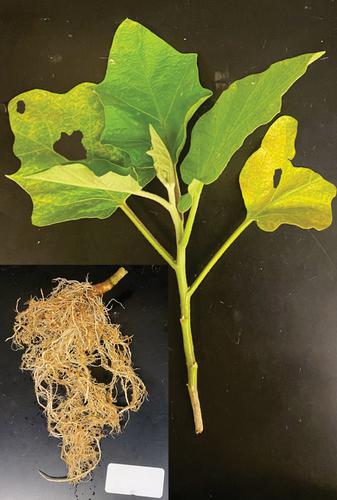Our official English website, www.x-mol.net, welcomes your
feedback! (Note: you will need to create a separate account there.)
Disentangling the influence of water limitation and simultaneous above and belowground herbivory on plant tolerance and resistance to stress
Journal of Ecology ( IF 5.3 ) Pub Date : 2021-05-10 , DOI: 10.1111/1365-2745.13684 Fabiane M. Mundim 1 , Ernane H.M. Vieira‐Neto 1 , Hans Alborn 2 , Emilio M. Bruna 1, 3
中文翻译:

解开水分限制和地上和地下同时食草对植物耐受性和抗逆性的影响
更新日期:2021-07-09
Journal of Ecology ( IF 5.3 ) Pub Date : 2021-05-10 , DOI: 10.1111/1365-2745.13684 Fabiane M. Mundim 1 , Ernane H.M. Vieira‐Neto 1 , Hans Alborn 2 , Emilio M. Bruna 1, 3
Affiliation

|
- Plants face multiple biotic and abiotic stressors simultaneously. Many species can tolerate and resist stress, but countermeasures differ between roots and leaves. Since herbivores and environmental conditions modulate costs and benefits of plant defence traits, stress responses are context-dependent. We examined whole-plant tolerance and resistance responses to individual and combined effects of above and belowground herbivory under variable water conditions.
- We manipulated water availability and access by two common herbivores (Spodoptera exigua caterpillars and Meloidogyne incognita nematodes) to Solanum lycocarpum. Plants were either watered based on historical regional averages or the 30% reduction predicted by IPCC studies. Herbivory treatments included isolated above (AG) and belowground (BG) attacks, simultaneous (AGBG) attacks and no-herbivory controls. We then parameterized generalized linear mixed-effects models with data on plant survival, leaf and root biomass accumulation, root complexity and terpenoid concentration.
- Foliar herbivory increased terpenoid concentrations in roots relative to no-herbivory plants under control water but decreased concentrations in both roots and leaves under drought. Similarly, root feeders increased concentrations of terpenoids in leaves under control water but decreased concentrations only in roots under drought. Plants challenged with AGBG herbivory had greater whole-plant biomass (i.e. tolerance) and lower total concentrations of defensive compounds (i.e. resistance) than plants exposed to no-herbivore controls, regardless of water conditions. Importantly, the capacity of plants to grow or produce terpenoids changes when herbivory level is considered. In plants exposed to AGBG herbivory, greater nematode infection was related to decreases in whole-plant biomass and marginal increases in total terpenoid concentration. Ultimately, accounting only for individual AG and BG responses would have led to different conclusions and underestimated the magnitude of S. lycocarpum's compensatory responses. A ‘whole-plant’ approach revealed that belowground herbivory is the primary driver of tolerance in plants surviving moderate water stress.
- Synthesis. Whole-plant responses to stress in variable environments are complex, and their comprehensive understanding requires accounting for belowground herbivores and root responses.
中文翻译:

解开水分限制和地上和地下同时食草对植物耐受性和抗逆性的影响
- 植物同时面临多种生物和非生物胁迫。许多物种可以耐受和抵抗压力,但根和叶之间的对策不同。由于食草动物和环境条件会调节植物防御性状的成本和收益,因此应激反应取决于环境。我们研究了整个植物对不同水条件下地上和地下食草动物的个体和综合影响的耐受性和抗性反应。
- 我们通过两种常见的食草动物(甜菜 夜蛾毛虫和南方根结线虫)操纵水的可用性和对茄属植物的访问。植物要么根据历史区域平均值浇水,要么根据 IPCC 研究预测的减少 30%。食草治疗包括孤立的地上 (AG) 和地下 (BG) 攻击、同时 (AGBG) 攻击和非食草控制。然后,我们使用植物存活、叶和根生物量积累、根复杂性和萜类化合物浓度的数据参数化广义线性混合效应模型。
- 在对照水下,相对于非食草植物,叶面食草增加了根中萜类化合物的浓度,但在干旱条件下降低了根和叶中的萜类化合物浓度。类似地,根系饲养者在对照水下增加了叶子中萜类化合物的浓度,但仅在干旱下降低了根中的萜类化合物浓度。与暴露于非食草动物对照的植物相比,受 AGBG 食草动物攻击的植物具有更高的全植物生物量(即耐受性)和更低的防御性化合物的总浓度(即抗性),无论水条件如何。重要的是,当考虑食草水平时,植物生长或产生萜类化合物的能力会发生变化。在暴露于 AGBG 食草动物的植物中,更大的线虫感染与整个植物生物量的减少和总萜类化合物浓度的边际增加有关。最终,S. lycocarpum的补偿反应。一种“全植物”方法表明,地下食草动物是耐受中等水分胁迫的植物耐受性的主要驱动因素。
- 合成。整株植物在可变环境中对压力的反应是复杂的,对它们的全面理解需要考虑地下食草动物和根系反应。











































 京公网安备 11010802027423号
京公网安备 11010802027423号